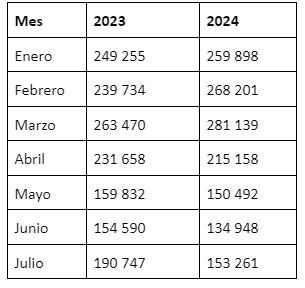Cuba Anticipates a 16% Decline in Tourists in 2024

Photo: elTOQUE.
The Cuban government has projected a 16% drop in tourist arrivals to the island for 2024. Consequently, the expected number of visitors has been revised from 3.2 million (as of December 2023) to 2.7 million.
This decrease aligns with figures published by the National Office of Statistics and Information (ONEI), which show a downward trend in visitor arrivals during the first seven months of 2024 compared to the previous year. From January to July 2024, Cuba recorded 1,463,097 international visitors, 15,263 fewer than the same period in 2023, representing a decline of 0.8%.
In July 2023, 190,747 visitors arrived on the island, 37,000 more than in July 2024. The data reveals a downward trend starting in April 2024 and a stagnation in the country’s tourism industry (see Table 1).

Table: Tourist Arrivals in the First Seven Months of 2023 and 2024 (ONEI)
In 2023, the tourism industry also failed to meet the Cuban government’s initial expectations. In December 2022, the goal was set to reach 3.5 million tourists; however, the final figure from ONEI reflected a 30% shortfall from the plan.
Three years after the sector’s paralysis due to COVID-19, the island has not been able to recover the visitor numbers that exceeded 4 million in 2019. This contrasts with other nearby destinations like Punta Cana (Dominican Republic) and Cancún (Mexico), which have matched or even surpassed their pre-pandemic figures.
According to the latest report from ForwardKeys —a European consultancy specializing in the air travel and tourism industry— Cuba ranks last (28th) in the Caribbean destinations for tourism recovery post-pandemic.
By the end of 2023, the Dominican Republic had welcomed over 10 million tourists, an unprecedented milestone for the country, which recorded 6,446,036 visitors in 2019.
Despite the stagnation in the tourism industry, the Cuban government continues to make substantial investments in the sector. In the first half of 2024, 14 times more was invested in tourism than in Public Health and Social Assistance, according to the official ONEI data.
The tourism sector accounted for 36.5% of the Cuban pesos invested during the first half of 2024, far exceeding the 2.5% allocated to investment in agriculture, despite the country’s food crisis.
Projections for tourist arrivals in 2024 indicate a significant decline. Regional competition, internal economic limitations, and the consequences of the US embargo (including the cancellation of the fast-track ESTA visa for Europeans visiting Cuba) are major obstacles to the industry’s revitalization.
Despite being aware of past statistics and the limitations hindering Cuba’s tourism development, the government continues to forecast unrealistic estimates while pouring millions into new hotels for an industry in decline.
This article was translated into English from the original in Spanish.










Comments
We moderate comments on this site. If you want to know more details, read our Privacy Policy
Your email address will not be published. Mandatory fields are marked with *
Drew